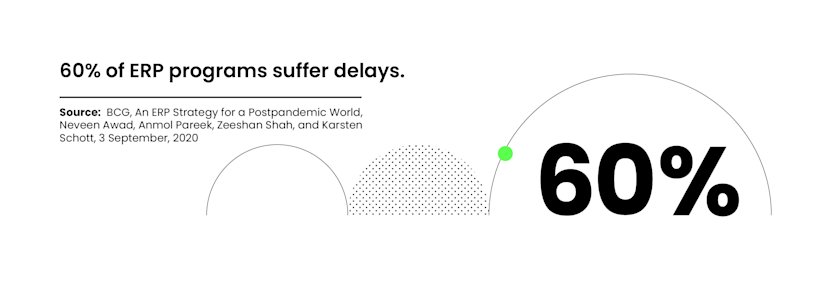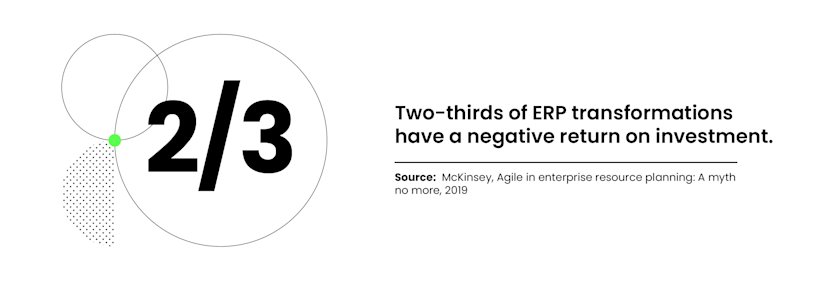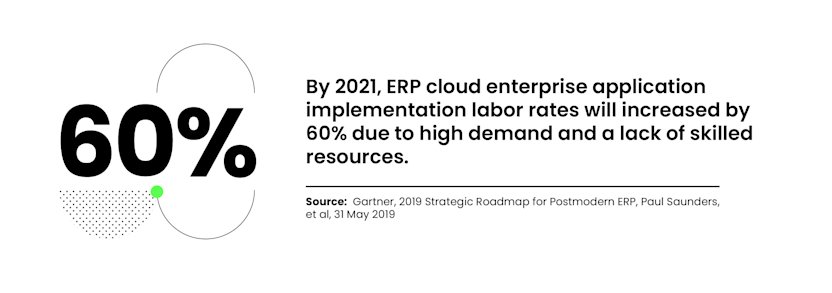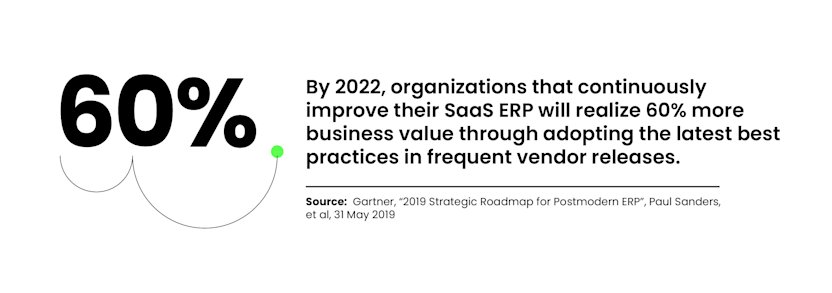
Define a System Migration Plan: Discover 6 Important Stats
For any big enterprise, continuous business transformation is a must. Companies merge, or acquire other companies. Processes get more complex. Technology evolves. Inevitably, the systems underpinning your business will struggle to meet your needs sooner or later. To stay agile and remain competitive, you’ll have to upgrade or replace existing systems by migrating their business processes to a new system landscape. And you don’t need us to tell you that system migrations are challenging (especially the one to S/4HANA). In this blog, we’ve crowdsourced the general wisdom about system migration — highlighting the risks but also the opportunities it can unlock. Read on to learn about trends, facts, and figures showing you how organizations strategize for and execute their system migration plan.

1. More than half of system migrations fail
System migrations are like a house of cards. One wrong move can bring the whole thing down — whether it’s poorly defined processes, the wrong business users in a workshop, or inflexible employees clinging to old workflows.

The reasons for this can be as diverse as the systems themselves. Maybe the new ERP has poor usability, the project had the wrong scope, your data is corrupted, your technical integrations don’t work, or your users just don’t know how to use the new system. The list is endless. But it all comes down to the following core problems companies face these days:
System migrations are the “ugly duckling” no one wants to do On the business side, system migrations are often seen as a necessary evil (or a technical upgrade at best) — when they’re actually a great opportunity for strategic improvement. On the IT side, leaders struggle to demonstrate the business value a system migration can bring. But when expectations and roadmaps aren’t aligned, how do you expect to keep your migration on track?
Low process visibility makes it hard to really improve operations Process complexity is at an all-time high. According to a recent Forrester study commissioned by Celonis, 71% of employees use 10 or more applications to execute a single business process. And yet, only 16% of leaders say they have complete process visibility. But without end-to-end process visibility across systems, businesses often end up migrating inefficient processes to their new system.
Sounds like you should throw in the towel? Not quite.
Yes, there are costs and risks. But a system migration can and should — if executed well — deliver real business outcomes: improved agility, better process visibility, higher productivity, and lower costs.
2. Few system migrations stay on schedule
Moving your business from one system to another is like building an airport. It requires extensive planning, timing, and most importantly, budgeting. If you don’t get it right from the start, your transformation project can easily end up like the infamous Berlin Brandenburg (BER) airport. The new, state-of-the-art German airport turned out to be catastrophic in every aspect, running billions over budget and 8 (!) years behind schedule.

Although aware of the risks and teething problems that come with a project of this scope, in our experience, both IT departments and executives often lack a detailed plan for challenges that can hit their bottom line.
You wouldn’t build an airport without a highly detailed blueprint and timeline. Same goes for system migrations. So think of what you want to accomplish and how you will get there. Think about potential challenges (security challenges, slow data migrations, longer downtimes) and how you plan to resolve them. And include some leeway (in terms of schedule and finances) for additional requirements that may crop up unexpectedly. Only then you can embark on your journey.
3. Two-thirds of system migrations have a negative ROI
System migration is a means to an end. You don’t re-engineer your technology landscape just for fun, you’re striving for better customer experience, new functionalities, agile processes, and greater business value. You simply can’t afford to spend hundreds of millions of dollars into a project that doesn’t recoup your investment. Unfortunately, that’s a fate many companies share. They either struggle to measure whether the project delivered on their business case or, in the worst cases, don’t see any ROI at all.

But if system migrations have little to no guarantee of delivering on the business value they promise, why do it?
In our experience, the problem of low value realization is rooted in the early requirement phase. Companies don’t take the time to define their expected business benefits and fail to engage with the business around goals early in the system migration project.
7 reasons why system migrations fail — and how you can avoid them
System migration step by step: The 5-step checklist for your migration project
More often, companies are desperate to address their immediate IT pain points or rush the migration process in order to sunset legacy tools. As a result, the C-level often overlooks the strategic value these projects can bring: Because system migrations plans should never just focus on replacing one system by another, but on transforming the entire business.
To keep business goals in focus, a data-driven approach is essential to assess your current process landscape. Design a solution that helps you achieve your goals, and continuously tie your process improvements to your outcomes. Only if you measure the business impact of optimizations at every stage of the migration, will you be able to ensure value realization and ROI.
4. Demand for experts is rising fast
Whether you’re upgrading, consolidating, harmonizing, or switching vendors, system migration is a huge strategic project that comes with major business implications, and therefore requires extensive expert attention. More and more companies are acknowledging the urgency of optimizing their system landscape. They also realize they need to get the right people on board sooner rather than later, because the demand for experts is rising fast.

A poorly run system migration project without clear guidance from experts can cause a cascade of problems — from extended downtime to data loss, budget overruns, and subpar performance. In the worst cases, it can disrupt entire operations and affect your bottom line.
5. Integration is key
Imagine a company where no one speaks the same language. No one knows what the other departments are doing, even though they’re working on the very same project. To make matters worse, each department is using a different system, and even within those departments, everyone has their own way of doing things — because there’s no communication. Sadly, this is a reality for a lot of companies. Why? Because they underestimate the interdependencies between their processes and departments.

Their systems are too often disconnected from each other, causing inefficiencies (like duplicate data entries), increasing error rates, and communication blocks. What should have helped them speed up actually ends up slowing them down. Take Customer Service and Supply Chain for example. A lack of integration may mean these departments act independently, with little information flow between them. The result? Your customer service manager will struggle to speed up a high value order for a customer that is threatening to go to your competitor.
6. Ignoring SaaS leaves value on the table
In the digital era, your ERP needs to perform faster, handle more data, and support new capabilities like AI, bots, or machine learning. All while staying 100% reliable and agile. As a result, a growing number of companies are considering migrating or have already moved their ERP to the cloud. This move can not only save implementation costs — but also bring greater business value in the long run.

The benefits go far beyond quicker implementation: It future-proofs your IT landscape to be flexible, scalable, and cost-efficient. Rather than waiting for an update every few years, companies with an ERP in the cloud can be sure to always be up to date with new releases.
Why system migration benefits everyone, not just IT
It’s understandable that you might be hesitant to embark on a system migration initiative. You’ve made significant investments in your legacy systems. You might even feel the pressure of cutting costs. But, if planned and executed properly, system migrations can bring tremendous business value. They can help you drive better business outcomes, lead to millions of dollars in savings each year, and deliver better customer experiences. The prerequisite for all that is to understand that a system migration is about more than just updating your legacy software. It’s an opportunity to consolidate your IT landscape and harmonize legacy processes, modernize the business, and create continuous value far beyond go-live. This is how you turn a system migration into an enterprise transformation.
What are you waiting for?




